Disclaimer: This post may contain Amazon affiliate links. Sudachi earns a small percentage from qualifying purchases at no extra cost to you. See disclaimer for more info.
What is Jingisukan?
Jingisukan is a Hokkaido specialty dish, where lamb is cooked raw or marinated in a sauce and grilled in a distinctive pan with vegetables such as onions, bean sprouts, peppers, and carrots. It is eaten in almost all parts of Hokkaido, as well as Jingisukan restaurants all across Japan.
It’s typically served with a sweet dipping sauce and rice. (Keeping with the Hokkaido theme, I also enjoy eating Jingisukan with a refreshing Sapporo beer!)

Where to Get Jingisukan Grill
If you’re wondering where to get a Jingisukan grill, it’s not easily available even in Japan, except in Hokkaido. However, you can buy it online from a wholesale shop that sells to restaurants. There are two types of Jingisukan grills: one with holes and one without. The one with holes is similar to a Korean-style grill, while the one without holes is more like a “Mongolian grill”. These grill plates, such as Nambu ironware, are mainly made of cast iron and have a unique shape with a raised central section like a helmet.
The purpose of the raised central section is to cook the lamb, while the vegetables are cooked in the lowered periphery, allowing the juice and fat from the lamb to drip downwards along the grooves to season the vegetables. If you don’t have a Jingisukan grill at home, you can use a frying pan instead. Just make sure to mix the vegetables around the pan so that they cook in the fat from the lamb.
However, if you want a proper setup to make Jingisukan, you can buy a “Mongolian BBQ grill” on Amazon USA, which is almost identical to the Jingisukan grill.
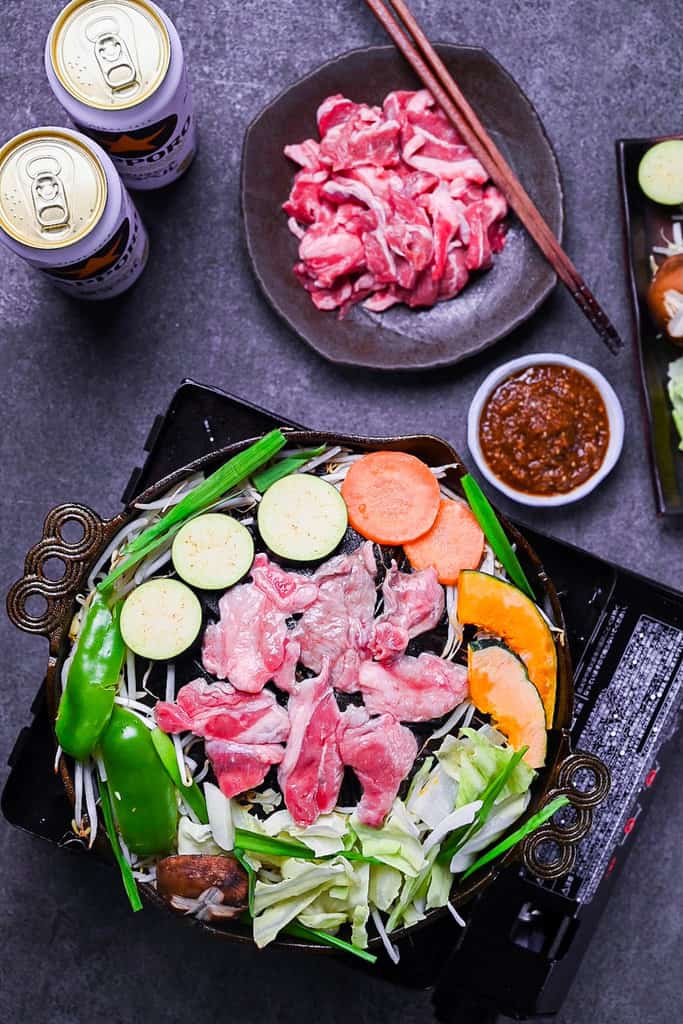
My Way of Eating Jingisukan at Home
As I mentioned already, there are different ways of cooking and eating Jingisukan, and there is no single right way. So, here, I will explain how I eat Jingisukan with my recipe at home.
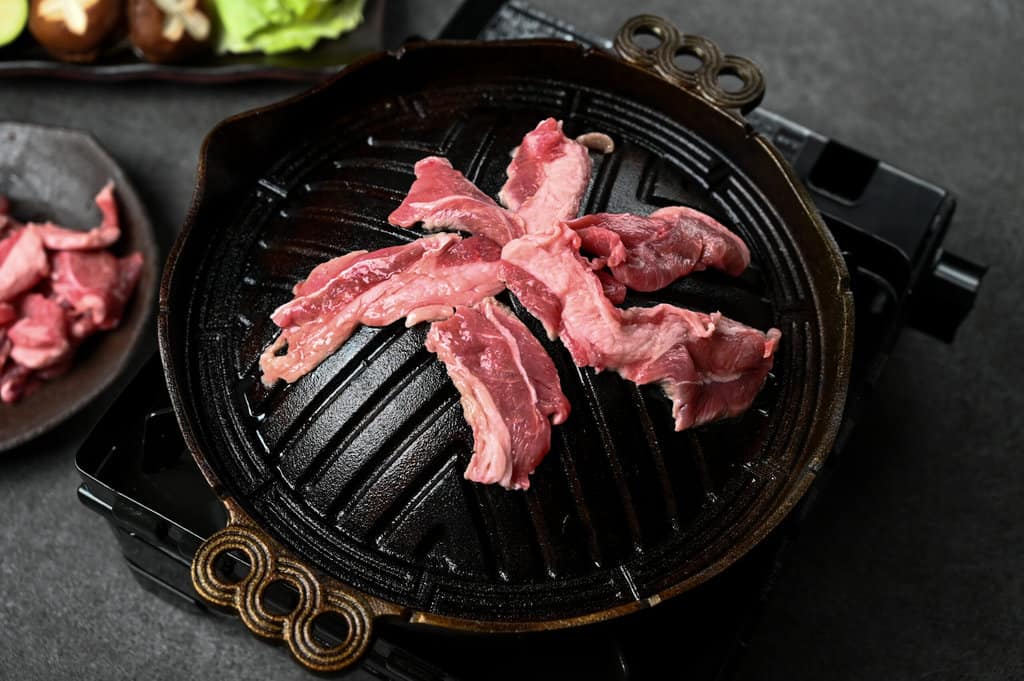
First, I only cook the lamb meat without any vegetables. The reason is simple, that is to let the lamb meat release its fat and juice all around the grill, in a way it’s oiling the surface. That way, vegetables that will be added after will be cooked in the juices from the lamb, delicious!
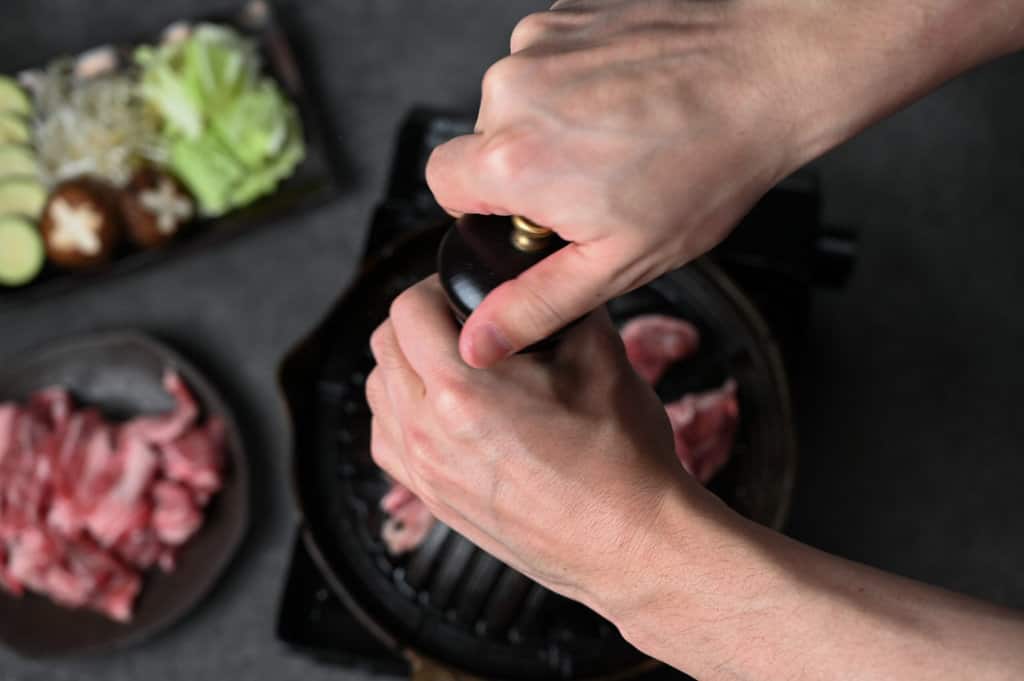
Preheat the grill on medium heat and add the lamb. Be sure to season it with salt and pepper and cook until browned.
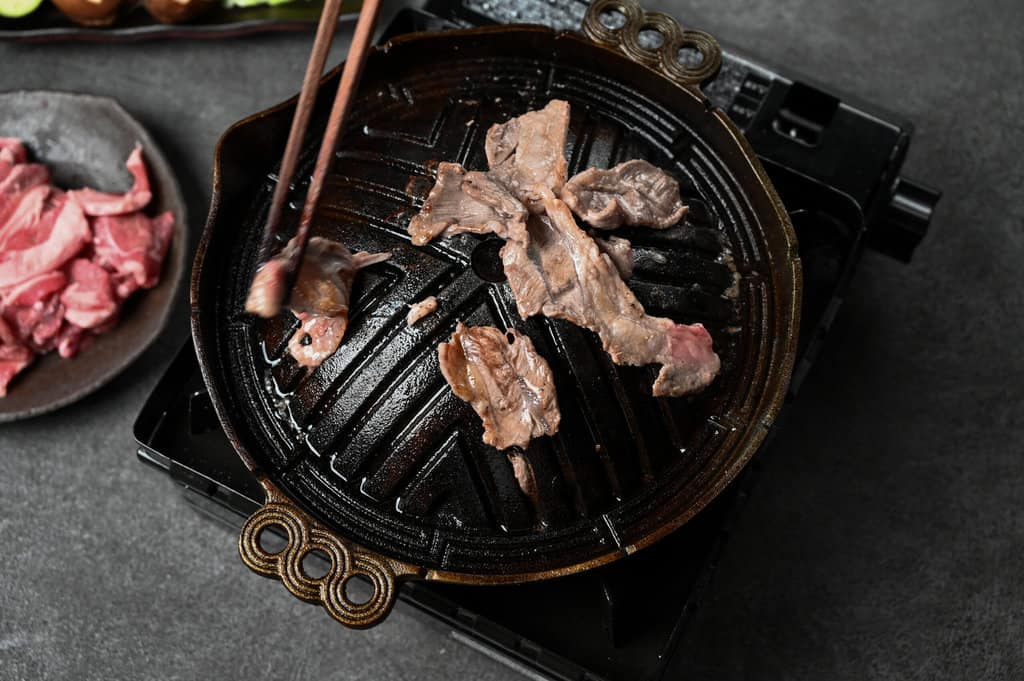
Once one side is browned, flip them over and cook the other side until browned as well. For the first batch, you can either eat them as they are (simply seasoned with salt and pepper) or dip them in the sauce already.
I personally eat the first ones only with salt and pepper to enjoy the lamb meat as it is!
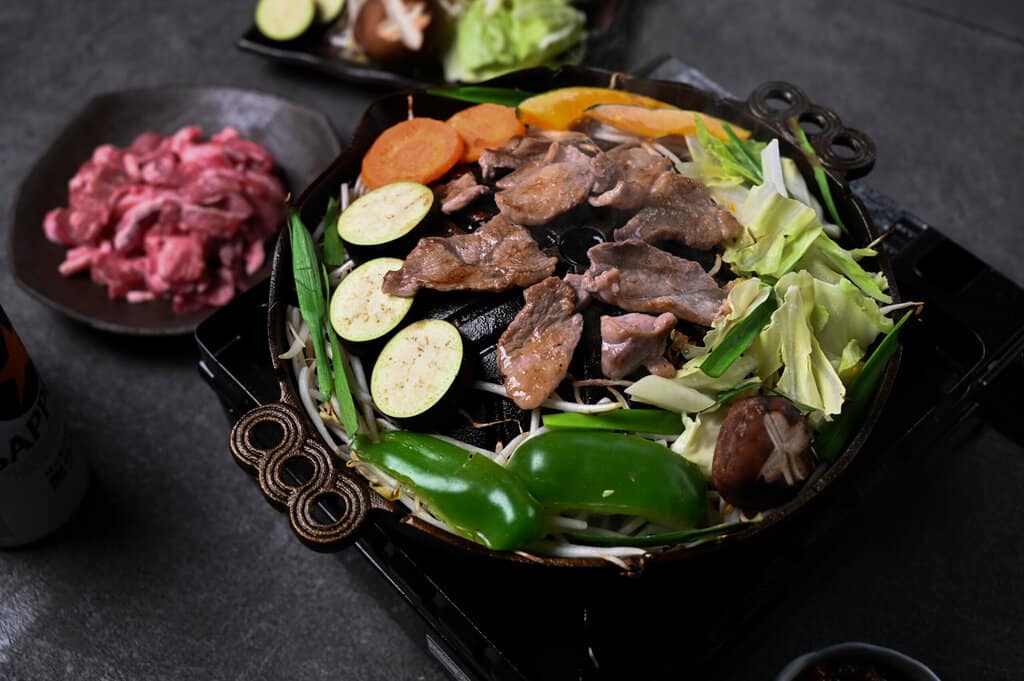
Add another batch of lamb meat on top and vegetables around lower edges. The idea is lamb meat’s juice and fat drizzles down to vegetables. This adds extra jingisukan flavor to the vegetables too!
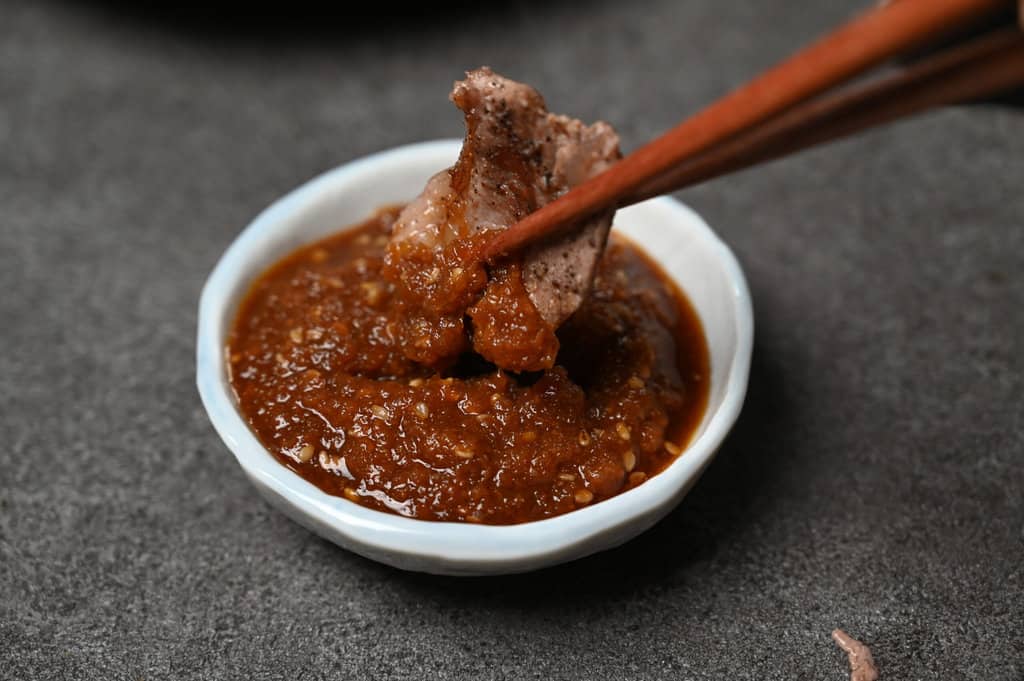
Once the lamb and vegetables are cooked enough, dip them into the homemade sauce and enjoy! It’s basically a BBQ so repeat the process until your ingredients run out!
Jingisukan is one of the most famous regional dishes to come from Hokkaido, and it’s truly delicious! I hope you enjoy my take on this special Japanese lamb dish with my homemade fruity sauce!
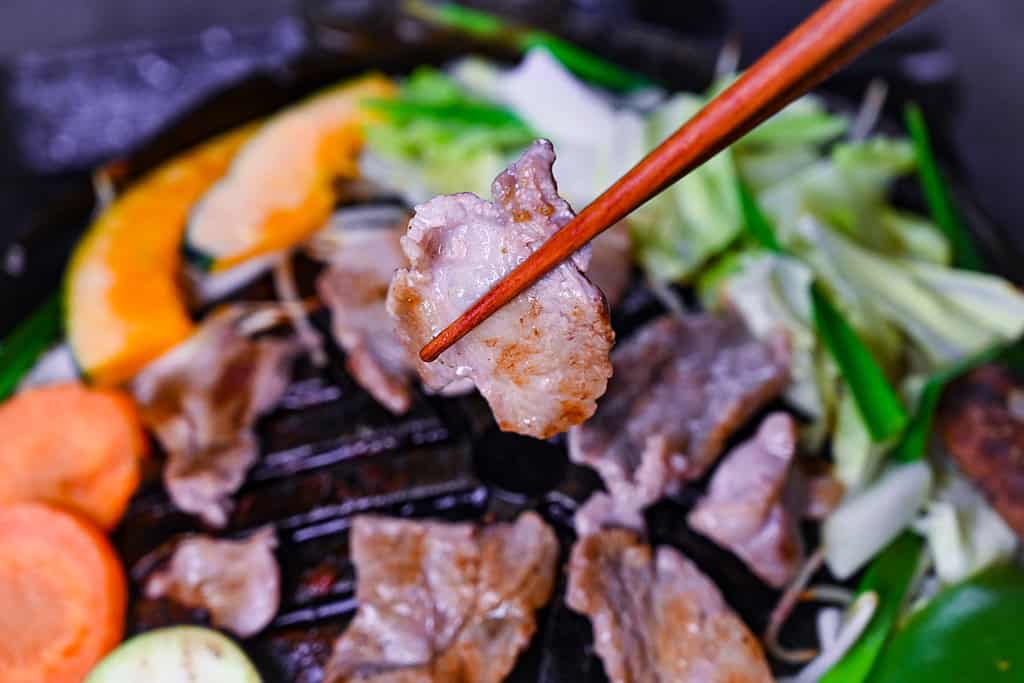
FAQ
In the Taisho era (1912-1926), cotton sheep farming was encouraged as a national policy when wool imports saw a steep decline. At that time, cotton sheep farming also became popular in Hokkaido, and it is said that the locals began consuming lamb. Since then, farming has changed from cotton to lamb because the amount of imported cotton began to increase again.
If you often eat Japanese food, you might have noticed that lamb dishes are not so common. Jingisukan is one of the few lamb dishes in Japanese cuisine.
There are various theories about the origin of Jingisukan, but it is said to have been invented around the beginning of the Showa period (1926-1946) with reference to a Chinese roast lamb dish.
As you may have guessed, Jingisukan is believed to be named after the infamous Genghis Khan. I’m sure it’s not a coincidence, but another interesting fact is that the grill used to cook Jingisukan looks almost identical to the Mongolian grill.
As lamb has a distinctive odor, there are two ways of eating Jingisukan:
Grilled raw and dipped in Jingisukan sauce
Marinated in soy sauce-based sauce
There is no right or wrong in this, but I make my own Jingisukan dipping sauce in my recipe, and don’t marinate. You can find that in Japanese supermarkets’ lamb sections if they have one, where they always offer those two kinds. At the end of the day, it’s all to do with your preference or which type you’re more familiar with.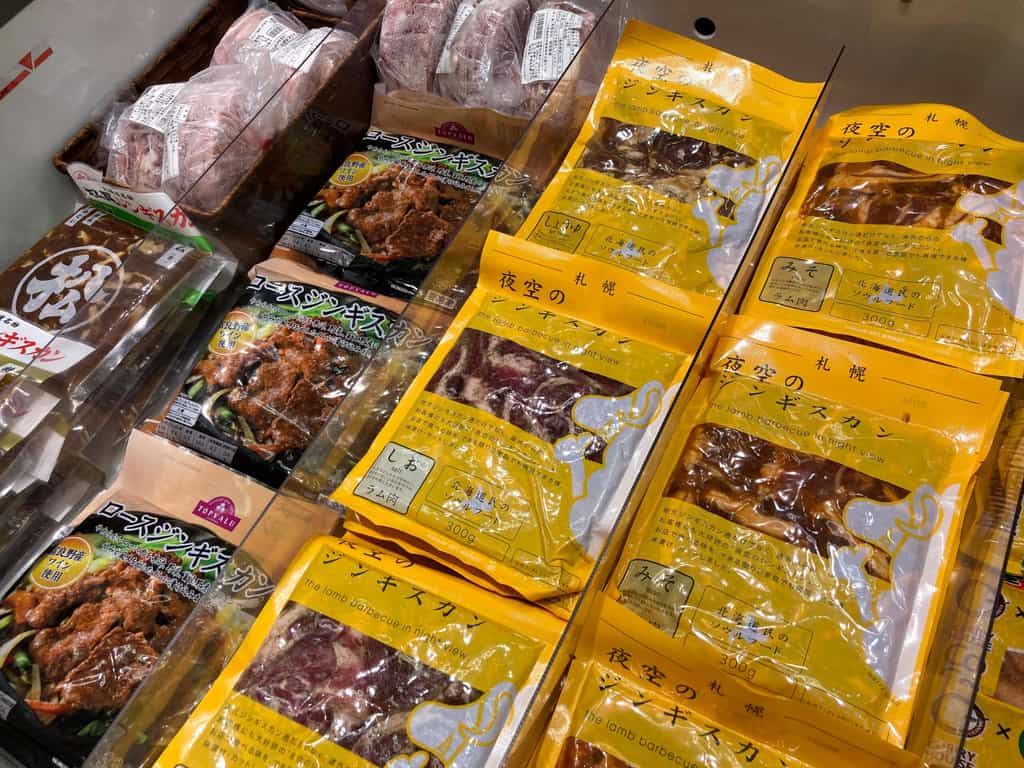
I hope you enjoy this Jingisukan recipe! If you try it out, I’d really appreciate it if you could spare a moment to let me know what you thought by giving a review and star rating in the comments below. It’s also helpful to share any adjustments you made to the recipe with our other readers. Thank you!
More BBQ Style Recipes
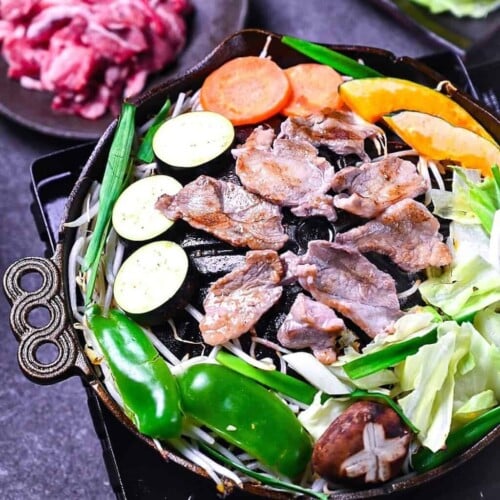
Jingisukan (Hokkaido Style Lamb BBQ)
Equipment
Ingredients
Jingisukan Sauce
- 150 g apple peeled
- 30 g carrot peeled
- 50 g onion
- 30 g pineapple
- 1 clove garlic
- 10 g ginger root
- ½ tbsp lemon juice
- 1 tsp honey
- 1 tsp chili powder cayenne pepper
- ¼ tsp rice vinegar
- 100 ml Japanese soy sauce (koikuchi shoyu)
- 25 ml water
- 25 ml red wine
- 1 tsp light brown sugar
- 1 tsp mirin
- 1 tsp ground sesame seeds
- ½ tbsp toasted white sesame seeds
Jingisukan (Main ingredients suggestion)
- 250 g lamb shoulder thinly sliced
- salt and pepper to taste
- 30 g carrot peeled and cut in rounds
- 50 g onion cut into wedges
- 50 g eggplant cut in rounds with skin on
- 2 fresh shiitake mushroom stem removed
- 50 g kabocha squash thinly sliced with skin on
- 100 g bean sprouts
- 50 g green cabbage roughly chopped
- 50 g bell pepper cut into strips
- 25 g garlic chive(s)
My recommended brands of ingredients and seasonings can be found in my Japanese pantry guide.
Can’t find certain Japanese ingredients? See my substitution guide here.
Instructions
Jingisukan Sauce
- Roughly cut 150 g apple, 30 g carrot, 50 g onion and 30 g pineapple into small chunks and place them in a food processor.
- Add ½ tbsp lemon juice, 1 tsp honey, 1 tsp chili powder, 1 clove garlic, 10 g ginger root, 1 tsp ground sesame seeds and ¼ tsp rice vinegar to the food processor, then blend everything together until no more large chunks remain.
- Take a small saucepan and add 100 ml Japanese soy sauce (koikuchi shoyu), 25 ml water, 25 ml red wine, 1 tsp light brown sugar, 1 tsp mirin, ½ tbsp toasted white sesame seeds along with the contents of the food processor.
- Place the pan on the stove and bring the sauce to a boil while stirring continuously to prevent burning.
- Once boiling, reduce the heat to medium-low and simmer for 3 minutes. Then, remove the pan from the heat and allow the sauce to cool down. If you have time, place it in the fridge until serving.
Jingisukan
- Heat the pan/grill on a medium heat. Once hot, place a few slices of lamb in the center and sprinkle with a pinch of salt a pepper. If using a frying pan, move the lamb around the pan to season the surface.
- Flip the lamb and cook on the other side. Once cooked, remove from the pan. (You can eat it now or save it for later.)
- Add more lamb, then the vegetables, starting with 50 g kabocha squash, 50 g onion, 30 g carrot, 2 fresh shiitake mushroom and 50 g eggplant. (These take longer to cook.)
- Once slightly softened, flip everything over and add 50 g green cabbage, 100 g bean sprouts, 50 g bell pepper and 25 g garlic chive(s). Make sure all the vegetables are touching the fat and juices from the lamb to flavour them.
- When the meat and vegetables are cooked, eat by dipping the ingredients in the homemade sauce and enjoy with rice.
- Repeat until all of your ingredients are finished.
- Enjoy!
Notes
- If you don’t have a food processor, you can grate your ingredients and use pineapple juice instead of pineapple chunks.
- Keep leftover sauce in the fridge in an airtight container and use within 3 days.
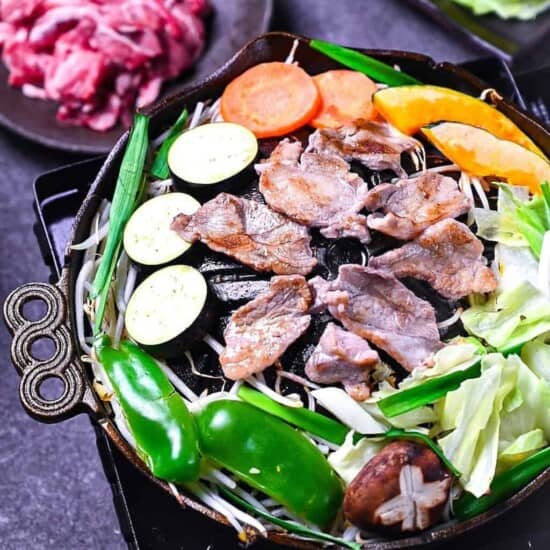


Hi
Where can I buy the Jingisukan meat in Tokyo (specifically in Yokohama)?
Thank you
C
Hi C,
I’m not sure specifically as I don’t live near Tokyo/Yokohama but I bought the lamb for jingisukan at Aeon supermarket. If you don’t live near Aeon, try any large supermarket (it will be near the beef/yakiniku meats) or butcher. Hope that helps!
Best wishes,
Yuto
In 1970-71 we were stationed at Chitose. We ate jingisukan at Namachan’s Restaurant. Never lamb, always beef. Cooked on a domed cast iron grill over a gas flame. We cooked it ourselves. Rubbed beef suet over the grill& quick grilled meat & veggies. It was delicious!
Thank you for sharing your experience, Jingisukan is well known for being a lamb dish but it is certainly delicious with beef too!